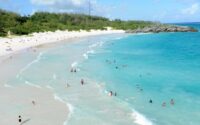I quit my job to travel the world during the pandemic
Last December, Jordan Hurt swam in the Pacific Ocean after skydiving from 10,000 feet above Manuel Antonio, a rugged national park in Costa Rica.
Mid-swim, the 32-year-old realized he needed a break from the Big Apple — a long break.
After nearly 10 years in New York and more than five working as an assistant to “Million Dollar Listing New York” real estate broker Ryan Serhant, Hurt questioned whether the hustle made him happy.
“The answer was no,” Hurt said. “As I was in the ocean … I just looked around and I was like, ‘Oh, it’s this. This is what I want.’ ”
When he returned to the city in January, he started plotting out a yearlong backpacking trip around the world. By the time his planned July departure rolled around, however, Hurt had to contend with myriad obstacles due to the coronavirus, which began its major US outbreak in March. Not only did the Centers for Disease Control recommend avoiding all nonessential travel, but the bulk of the world’s nearly 200 countries shut their borders to US travelers — and remain that way.
“There was maybe one moment within that first stretch of quarantine that I thought, ‘Oh, I’m not going to be able to do this,’ ” said the Ohio native. “I knew I had to stay hopeful … and figure out a way for it to be possible.”

Clinging to a now-or-never mentality, Hurt had already budgeted the time and money for the trip.
“If I would have waited another year, my life could be completely different,” said Hurt. “I didn’t own [my] apartment, I didn’t have a partner, I didn’t have a dog … I was like, ‘Pull the cord, let’s go.’ ”
So, on July 5 — a day after receiving negative COVID-19 test results — he set off on his adventure. In his bag, he packed a stack of bandanas to wear over surgical masks.
First came a 14-day quarantine in a London Airbnb, where he watched Netflix and ordered fish and chips via Uber Eats. He chose the United Kingdom as a starting point, he said, because it allows US citizens to enter with the requisite two weeks’ isolation.
After the mandatory quarantine ended, he boarded a train for Gare du Nord station in Paris. Coming from the UK, he was able to enter France regardless of his own citizenship.
Hurt did have to reroute his itinerary three times to accommodate destinations that allow travelers. Initially, at the onset of the outbreak in the US in March, he figured he could begin in Guatemala and work his way down into South America. But the coronavirus soon spread to that region, with countries including Brazil, Chile and Peru continuing to battle major outbreaks. (Latin America has since recorded more than 5.4 million infections and more than 210,000 deaths.) So he switched tack and set his sights on Europe.

Hurt stayed with friends in Paris, then took a bus to Bordeaux and traveled the Atlantic coast, where he climbed Dune Du Pilat, Europe’s tallest sand dune. From there, he took a long-distance rideshare to Madrid — and has since driven through southern Spain, hitting Seville, Cadiz, Tarifa, Malaga and Granada, chronicling his stops on social media.
Coronavirus cases in Spain, however, have risen throughout July and August — and on Tuesday, national health authorities announced 8,618 new cases arose over the previous four days. Hurt is keeping his eyes on cases in Barcelona, which he wants to visit before making his way to Italy via France.
“There is a huge lack of tourism,” he said, adding that visits to tourist hot spots like Buckingham Palace in London and the Plaza de España in Seville have been blissfully empty. “I’m just going with the flow and it’s different.”
There are other Americans around Europe — though not nearly as many as during any typical summer. One traveler from Miami told Politico he also reached Spain via the United Kingdom, where authorities didn’t require him to isolate during a layover at London’s Heathrow airport. When he arrived in Barcelona, he was treated as a UK citizen and allowed to enter.
Even while forging ahead with his grand adventure, Hurt added, he’s being responsible.

“Every single place I go, I wear a mask … and I wear a mask every day on the streets,” he said — adding that he also frequently uses publicly accessible hand sanitizer and stays 6 feet from others.
“At the end of the day, I come in peace,” he said. “I’m coming to experience different cultures and experience different beautiful landmarks … I’m not coming to be some fool out here.”
When he’s not sightseeing, he’s eating at restaurants, where he’s been able to dine inside as long as he wears a mask until reaching the table. And staying in hostels, he’s made some friends, including a man from London with a similar backpacking route with whom Hurt has been traveling in Spain. Otherwise, he said, “there is a certain amount of time I’m spending alone,” though he added that doesn’t bother him.
Unlike in New York, museums and other attractions are open in Europe with social-distancing measures and timed tickets. Hurt hasn’t encountered a site he’s wanted to see but couldn’t due to COVID-19.
For now, he’s in Europe for a couple more months before trekking to Turkey, where Americans can enter with a visa after being checked for COVID-19 symptoms. He aims to head to Israel in October, but since March 18, Israel’s government has barred all foreigners from entering its borders.
“[Coronavirus] has presented me with challenges and obstacles along the way, but in a way it kind of adds to the adventure,” said Hurt. “In the meantime, I’m out seeing the world.”
What’s more: He also hopes to reach Australia and previously COVID-free New Zealand, both of which have also sealed their borders to new arrivals. Other target destinations for 2021 include India and southeast Asia.
“This is going to be one of those opportunities to really grow,” he said. “It’s great to be alive and it’s great to be experiencing this time in my life.”


